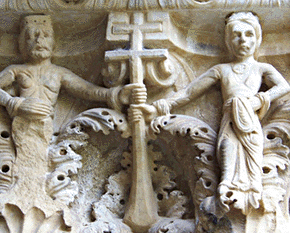...Best of Sicily presents... Best of Sicily Magazine. ... Dedicated to Sicilian art, culture, history, people, places and all things Sicilian. |
by Vincenzo Salerno | ||
Magazine Index Best of Sicily Arts & Culture Fashion Food & Wine History & Society About Us Travel Faqs Contact Map of Sicily |
Alas, that is precisely the problem with the surviving work of Hugo (Hugh) "Falcandas," who wrote extensively about the reigns of William I and his son, William II of Sicily, from 1154 to 1169, effectively the period immediately following the death of Roger II. Falcandas (not his actual surname) had a low opinion about just about everybody at court, attributing to many of them the worst possible motives. Falcandas, it seems, saw a little bit of the devil in every man, though in cases such as that of Matthew Bonellus, the rebellious Norman lord of Caccamo who actually planned and executed a revolt against his king, Hugo's suspicions were probably justified. Yet Maio of Bari, Stephen of Perche and other high functionaries are maligned to the same degree. Hugo's highly critical manuscript, known as "The History of the Tyrants of Sicily" (more properly "Liber de Regno Siciliae"), was published only in 1550. It is thought that he may also be the author of "Epistola ad Petrum Panormitane ecclesie thesaurarium de calamitate Sicilie," long thought to be a kind of preface to "Liber de Regno." It was a lively period, and an important one in Sicilian history, but who was Hugo Falcandas? Historians cannot agree on his identity. Evelyn Jamison, a highly distinguished scholar specialised in Norman-Italian medieval history, suggested that he might well be Eugene (1130-1202), who eventually achieved the position of admiral at the royal court. Eugene was of Byzantine Greek ancestry, descended from an important Palermitan family, and fluent in Greek and Arabic. He was a very learned man and held a series of important positions in the Kingdom of Sicily. By all accounts, he was probably the kind of man who did not "suffer fools gladly," and he may well have viewed in a very negative light those men appointed to high positions based on factors other than merit, even if this was normal in the times he lived. This does seem to contrast with the rival theory that "Falcandas" was, in fact, a Norman himself, but it explains the author's negativity about the majority of Normans in Sicily. What is almost certain is that Falcandas, with his privileged access to the government and court, unlike most chroniclers of his time, was not a monk. Were it not for Falcandas, whoever he was, the identities of many personages of the period would not even be known to us. The work of Amatus of Monte Cassino, to mention just one contemporary chronicler, does not attempt either the detail or nuance of Falcandas, who was undoubtedly present in Sicily to witness the events he describes. Even so, comparing Hugo's prose to that of Tacitus, as some have done, seems like wishful thinking. Of course, nobody is perfect. The personality of Falcandas, whoever he was, need not glitter for his work to be more precious than gold. About the Author: Palermo native Vincenzo Salerno has written biographies of several famous Sicilians, including Frederick II and Giuseppe di Lampedusa. | |
Top of Page |
 Let's say that a historical
chronicle were discovered describing important medieval events, but with
a good deal of bias and what today's journalists call "spin."
The author, whose precise name and identity we do not know, seems like an
obnoxious, cynical individual, yet the information he presents is so important,
filling in many gaps, that we cannot possibly dismiss all of it out-of-hand
as if it were mere nonsense. What is more, the details we can confirm with
other sources seem to indicate the chronicler's privileged position at the
royal court about which he writes.
Let's say that a historical
chronicle were discovered describing important medieval events, but with
a good deal of bias and what today's journalists call "spin."
The author, whose precise name and identity we do not know, seems like an
obnoxious, cynical individual, yet the information he presents is so important,
filling in many gaps, that we cannot possibly dismiss all of it out-of-hand
as if it were mere nonsense. What is more, the details we can confirm with
other sources seem to indicate the chronicler's privileged position at the
royal court about which he writes.